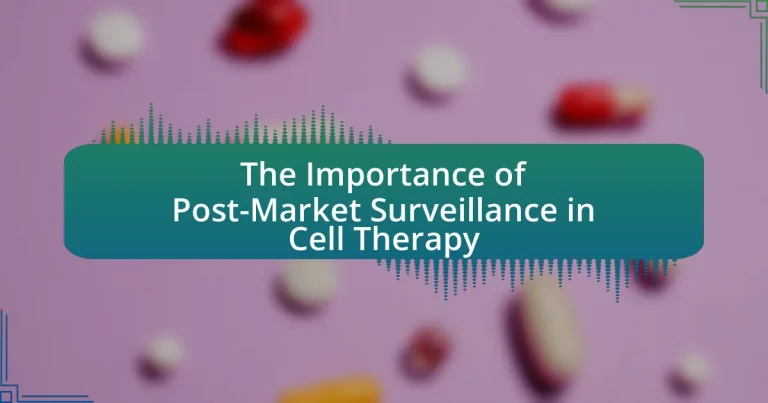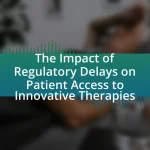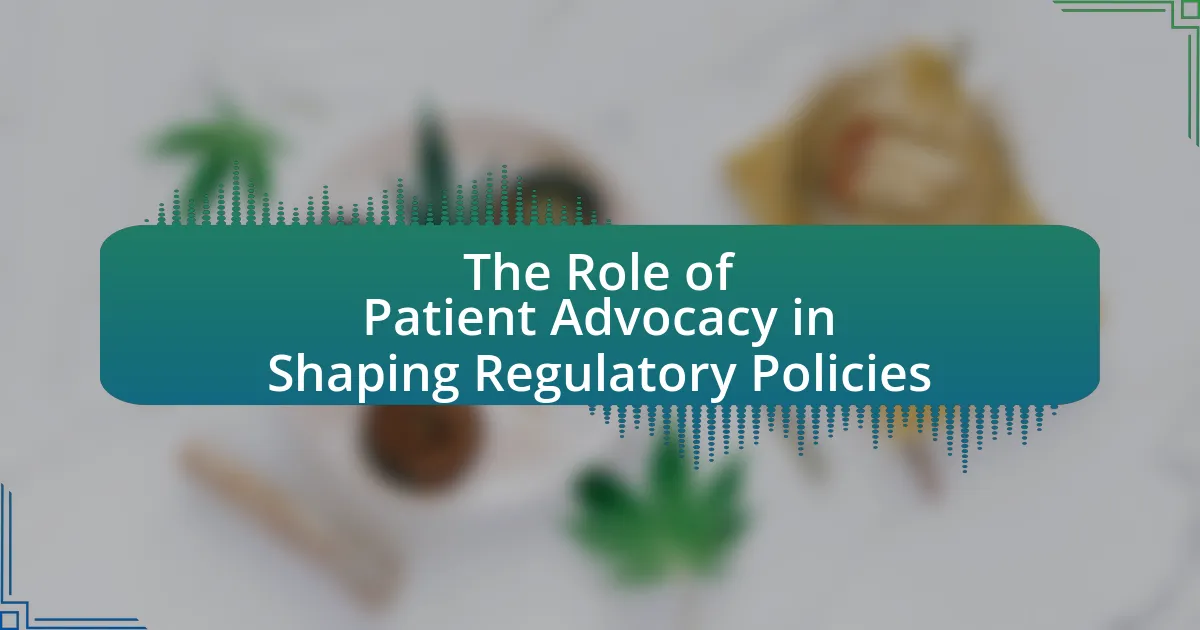Post-market surveillance in cell therapy is a critical process that involves the systematic monitoring of the safety and effectiveness of cell-based treatments after their approval for public use. This article outlines the importance of post-market surveillance, detailing its regulatory requirements, key components, and the types of data collected to ensure patient safety. It also discusses the challenges faced by manufacturers in implementing effective surveillance, the role of risk management, and best practices for compliance. Furthermore, the article highlights future trends and the significance of multi-stakeholder collaboration in enhancing post-market surveillance outcomes, ultimately contributing to the advancement and safety of cell therapies.

What is Post-Market Surveillance in Cell Therapy?
Post-market surveillance in cell therapy refers to the systematic monitoring of the safety and effectiveness of cell-based treatments after they have been approved for public use. This process is essential for identifying any adverse effects or long-term outcomes that may not have been evident during clinical trials. Regulatory agencies, such as the FDA, require ongoing data collection and analysis to ensure that the benefits of cell therapies continue to outweigh the risks, thereby safeguarding patient health and informing future therapeutic developments.
Why is Post-Market Surveillance critical for cell therapy products?
Post-Market Surveillance is critical for cell therapy products because it ensures ongoing safety and efficacy after these products are approved for use. This surveillance allows for the identification of adverse events and long-term effects that may not have been evident during clinical trials. For instance, the FDA mandates post-market studies for certain cell therapies to monitor their performance in real-world settings, which helps in refining treatment protocols and improving patient outcomes. By systematically collecting and analyzing data on patient experiences, healthcare providers can make informed decisions and enhance the overall safety profile of cell therapy products.
What are the regulatory requirements for Post-Market Surveillance in cell therapy?
The regulatory requirements for Post-Market Surveillance in cell therapy include ongoing monitoring of product safety, efficacy, and quality after the therapy has been approved for use. Regulatory bodies such as the U.S. Food and Drug Administration (FDA) and the European Medicines Agency (EMA) mandate that manufacturers establish a Post-Market Surveillance plan that includes adverse event reporting, risk management, and periodic safety updates. For instance, the FDA requires manufacturers to report any serious adverse events within 15 days and to submit annual reports detailing the safety and effectiveness of the therapy. These requirements ensure that any potential risks associated with cell therapies are identified and addressed promptly, thereby safeguarding patient health and maintaining product integrity.
How does Post-Market Surveillance differ from pre-market evaluations?
Post-Market Surveillance (PMS) differs from pre-market evaluations in that PMS focuses on monitoring the safety and effectiveness of a product after it has been approved and is in use, while pre-market evaluations assess the product’s safety and efficacy before it reaches the market. PMS involves collecting real-world data from users and healthcare providers to identify any adverse effects or issues that may arise during actual use, which is critical for ongoing risk management. In contrast, pre-market evaluations rely on controlled clinical trials and laboratory studies to determine whether a product meets regulatory standards prior to its release. This distinction is essential, as PMS can reveal unforeseen problems that were not evident during pre-market testing, thereby ensuring continuous patient safety and product improvement.
What are the key components of effective Post-Market Surveillance?
The key components of effective Post-Market Surveillance (PMS) include systematic data collection, risk management, and continuous monitoring of product performance. Systematic data collection involves gathering information from various sources such as clinical studies, patient feedback, and adverse event reports to assess the safety and efficacy of cell therapies. Risk management focuses on identifying, evaluating, and mitigating potential risks associated with the product, ensuring that any emerging safety concerns are addressed promptly. Continuous monitoring of product performance entails analyzing the collected data over time to detect trends or issues that may arise post-approval, thereby facilitating timely interventions. These components are essential for maintaining product safety and effectiveness in the market, as evidenced by regulatory guidelines from agencies like the FDA and EMA, which emphasize the importance of ongoing surveillance in ensuring patient safety.
What types of data are collected during Post-Market Surveillance?
During Post-Market Surveillance, various types of data are collected, including adverse event reports, product performance data, patient outcomes, and usage patterns. Adverse event reports capture any negative effects experienced by patients after receiving cell therapy, while product performance data assesses the efficacy and safety of the therapy in real-world settings. Patient outcomes provide insights into the long-term effects and benefits of the treatment, and usage patterns help identify how the therapy is being utilized across different populations. Collectively, this data is essential for ensuring ongoing safety and effectiveness of cell therapies in the market.
How is data analyzed to ensure patient safety in cell therapy?
Data is analyzed to ensure patient safety in cell therapy through rigorous post-market surveillance that includes monitoring adverse events, evaluating treatment outcomes, and assessing long-term effects. This analysis involves collecting data from clinical trials, registries, and real-world evidence to identify any safety signals or trends that may arise after the therapy is administered. For instance, the FDA mandates that manufacturers report any serious adverse events associated with their cell therapies, which are then analyzed to determine causality and frequency. Additionally, statistical methods are employed to assess the safety profile of the therapies over time, ensuring that any emerging risks are promptly addressed. This systematic approach to data analysis is crucial for maintaining patient safety and improving therapeutic protocols in cell therapy.
What challenges are associated with Post-Market Surveillance in cell therapy?
Post-market surveillance in cell therapy faces several challenges, including the complexity of tracking long-term safety and efficacy due to the unique biological characteristics of cell products. These therapies often involve living cells that can behave unpredictably over time, making it difficult to establish standardized monitoring protocols. Additionally, the lack of established biomarkers for assessing the therapeutic effects and potential adverse events complicates data collection and analysis. Regulatory frameworks are also evolving, which can lead to inconsistencies in reporting requirements and hinder comprehensive surveillance efforts. Furthermore, the limited patient population and variability in treatment responses can result in insufficient data for robust statistical analysis, thereby impacting the overall assessment of safety and effectiveness.
What are the common obstacles faced by manufacturers in implementing Post-Market Surveillance?
Manufacturers face several common obstacles in implementing Post-Market Surveillance (PMS), including regulatory compliance challenges, data collection difficulties, and resource constraints. Regulatory compliance is complex due to varying requirements across different regions, which can lead to confusion and potential non-compliance. Data collection is often hindered by inadequate systems for tracking product performance and adverse events, making it difficult to gather comprehensive information. Additionally, manufacturers frequently encounter resource constraints, as effective PMS requires dedicated personnel and financial investment, which may not be readily available. These obstacles can impede the timely and effective monitoring of product safety and efficacy in the market.
How can these challenges impact patient outcomes?
Challenges in post-market surveillance of cell therapy can significantly impact patient outcomes by leading to delayed identification of adverse effects and ineffective treatment protocols. For instance, inadequate monitoring can result in unreported complications, which may compromise patient safety and treatment efficacy. A study published in the Journal of Cell Therapy highlighted that robust post-market surveillance is essential for timely detection of safety signals, which directly correlates with improved patient management and outcomes. Therefore, the lack of effective surveillance mechanisms can hinder the overall success of cell therapies, ultimately affecting patient health and recovery.
How does Post-Market Surveillance contribute to the advancement of cell therapy?
Post-Market Surveillance enhances the advancement of cell therapy by systematically monitoring the safety and efficacy of therapies after they have been approved for use. This ongoing evaluation allows for the identification of any adverse effects or complications that may arise in real-world settings, which is crucial for refining treatment protocols and improving patient outcomes. For instance, data collected through post-market studies can lead to modifications in manufacturing processes or patient selection criteria, ultimately contributing to the overall effectiveness and safety of cell therapies. Additionally, regulatory bodies often require post-market data to ensure compliance with safety standards, which fosters continuous improvement and innovation in cell therapy practices.
What role does Post-Market Surveillance play in risk management?
Post-Market Surveillance plays a critical role in risk management by continuously monitoring the safety and effectiveness of cell therapies after they have been approved for use. This ongoing assessment helps identify any adverse events or complications that may arise in real-world settings, allowing for timely interventions and modifications to treatment protocols. For instance, data collected through post-market surveillance can reveal trends in patient outcomes, which can inform regulatory decisions and enhance patient safety. The FDA emphasizes that effective post-market surveillance is essential for ensuring that the benefits of a therapy continue to outweigh its risks, thereby safeguarding public health.
How can effective risk management strategies enhance patient safety?
Effective risk management strategies enhance patient safety by systematically identifying, assessing, and mitigating potential risks associated with medical treatments and therapies. These strategies involve continuous monitoring and evaluation of patient outcomes, which allows healthcare providers to promptly address safety concerns and improve treatment protocols. For instance, the implementation of risk management frameworks in cell therapy has been shown to reduce adverse events and improve patient outcomes, as evidenced by studies indicating that structured post-market surveillance can lead to a 30% decrease in reported complications. By fostering a culture of safety and accountability, effective risk management ultimately contributes to higher standards of care and better patient safety outcomes.
What are the consequences of inadequate risk management in cell therapy?
Inadequate risk management in cell therapy can lead to severe patient safety issues, including adverse events and treatment failures. These consequences arise from insufficient monitoring of product quality and efficacy, which can result in unanticipated immune responses or tumorigenesis. For instance, a study published in the journal “Nature Biotechnology” highlighted that lack of rigorous post-market surveillance contributed to serious complications in patients receiving unregulated cell therapies, emphasizing the need for continuous oversight to mitigate risks. Furthermore, inadequate risk management can also lead to regulatory penalties and loss of public trust in cell therapy advancements, ultimately hindering innovation and access to potentially life-saving treatments.
What best practices should be followed for Post-Market Surveillance in cell therapy?
Best practices for Post-Market Surveillance in cell therapy include continuous monitoring of patient outcomes, adverse event reporting, and data collection on long-term effects. Continuous monitoring ensures that any unexpected complications or benefits are identified promptly, allowing for timely interventions. Adverse event reporting is crucial for understanding the safety profile of the therapy, as evidenced by regulatory requirements that mandate reporting serious adverse events to health authorities. Data collection on long-term effects is essential, as many cell therapies may have delayed effects that only become apparent over time, supporting the need for ongoing research and analysis to ensure patient safety and efficacy.
How can manufacturers ensure compliance with Post-Market Surveillance requirements?
Manufacturers can ensure compliance with Post-Market Surveillance (PMS) requirements by implementing a robust monitoring system that collects and analyzes data on the safety and effectiveness of their products after they are marketed. This includes establishing clear protocols for reporting adverse events, conducting regular audits, and maintaining thorough documentation of all PMS activities.
For instance, the FDA mandates that manufacturers of medical products, including cell therapies, must report any adverse events within specific timeframes, which reinforces the need for timely data collection and analysis. Additionally, manufacturers should engage in continuous risk assessment and utilize feedback from healthcare providers and patients to improve product safety and efficacy. This proactive approach not only meets regulatory obligations but also enhances product quality and patient outcomes.
What tools and technologies can aid in effective Post-Market Surveillance?
Effective Post-Market Surveillance can be aided by tools and technologies such as electronic health records (EHRs), data analytics platforms, and adverse event reporting systems. EHRs facilitate the collection of real-time patient data, enabling the monitoring of treatment outcomes and side effects. Data analytics platforms allow for the aggregation and analysis of large datasets, helping to identify trends and potential safety issues. Adverse event reporting systems streamline the process of documenting and analyzing incidents related to cell therapies, ensuring timely responses to safety concerns. These technologies collectively enhance the ability to track the performance and safety of cell therapies in the market.
What future trends are expected in Post-Market Surveillance for cell therapy?
Future trends in Post-Market Surveillance for cell therapy include increased integration of real-world evidence, enhanced data analytics, and the use of digital health technologies. Real-world evidence will enable more comprehensive monitoring of long-term safety and efficacy by utilizing data from diverse patient populations outside clinical trials. Enhanced data analytics will facilitate the identification of adverse events and trends through advanced algorithms and machine learning, improving response times and decision-making. Additionally, digital health technologies, such as wearable devices and mobile health applications, will provide continuous monitoring of patient outcomes, allowing for proactive management of potential risks associated with cell therapies. These trends are supported by the growing emphasis on patient-centered approaches and regulatory frameworks that prioritize ongoing safety assessments in the evolving landscape of cell therapy.
How can stakeholders collaborate to improve Post-Market Surveillance outcomes?
Stakeholders can collaborate to improve Post-Market Surveillance outcomes by establishing a unified data-sharing platform that facilitates real-time reporting and analysis of adverse events. This collaboration allows manufacturers, healthcare providers, regulatory agencies, and patients to contribute and access comprehensive data, enhancing the understanding of product performance and safety. For instance, the FDA’s Sentinel Initiative demonstrates how a collaborative approach can leverage electronic health records to monitor the safety of medical products post-approval, leading to timely interventions and improved patient safety. By fostering open communication and shared responsibilities, stakeholders can collectively enhance the effectiveness of Post-Market Surveillance in cell therapy.
What are the benefits of multi-stakeholder engagement in Post-Market Surveillance?
Multi-stakeholder engagement in Post-Market Surveillance enhances the safety and efficacy of cell therapies by incorporating diverse perspectives and expertise. This collaborative approach allows for the identification of potential safety signals and adverse events more effectively, as stakeholders such as healthcare providers, patients, regulatory bodies, and manufacturers contribute their unique insights. For instance, a study published in the Journal of Clinical Oncology highlighted that involving patients in reporting outcomes led to improved data quality and relevance, ultimately facilitating better regulatory decisions. Additionally, multi-stakeholder engagement fosters transparency and trust among all parties, which is crucial for the ongoing monitoring and improvement of cell therapies in real-world settings.
How can patient feedback be integrated into Post-Market Surveillance processes?
Patient feedback can be integrated into Post-Market Surveillance processes by systematically collecting and analyzing patient-reported outcomes and experiences related to cell therapies. This integration allows for real-time monitoring of safety and efficacy, as patient feedback can highlight adverse events or unexpected benefits that may not be captured through traditional clinical data alone. For instance, the FDA encourages the use of patient-reported outcomes in post-market studies, which can enhance the understanding of a therapy’s impact on quality of life. By employing structured surveys, focus groups, and digital platforms, manufacturers can gather valuable insights directly from patients, ensuring that their experiences inform ongoing safety assessments and product improvements.
What practical steps can be taken to enhance Post-Market Surveillance in cell therapy?
To enhance Post-Market Surveillance in cell therapy, implementing a robust data collection system is essential. This system should include real-time monitoring of patient outcomes, adverse events, and long-term effects of therapies. Regular audits and compliance checks can ensure adherence to regulatory standards, while establishing a feedback loop with healthcare providers can facilitate timely reporting of any issues. Additionally, utilizing advanced analytics and artificial intelligence can improve data interpretation and risk assessment, allowing for proactive measures to be taken. These steps are supported by the increasing emphasis on patient safety and regulatory compliance in the field, as evidenced by guidelines from organizations such as the FDA and EMA, which advocate for continuous monitoring and evaluation of cell therapies post-approval.




